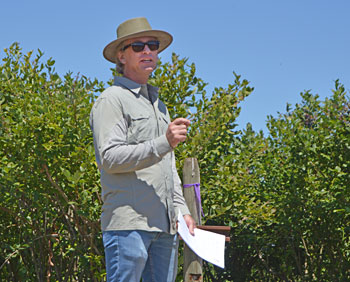Research Looks at Nutrient Needs in Blueberries
A multi-year research project analyzing the effectiveness of different nutrient application methods found that regardless of how it was applied, phosphorus applications increased the phosphorus in the soil, but had no effect on yield or fruit quality.
“And, interestingly enough, it did not have an effect on leaf phosphorus,” said USDA-ARS plant physiologist David Bryla. “Typically, you would expect if you put on a fertilizer, it should at least show up in the leaf tissue.”
The multi-year project looked at phosphorus, potassium and boron, among other nutrients.
 |
USDA-ARS plant physiologist David Bryla, at the Oregon Blueberry Field Day last summer in Aurora, discusses nutrient management in blueberries. |
Researchers did find increased phosphorus concentrations in the roots when they dug up plants, he said. “And what was really interesting is those plants that were fertilized with granular phosphorus had almost no colonization by the symbiotic fungi called mycorrhizal fungi,” the beneficial organisms that colonize roots and help plants take up nutrients.
“So, we actually had what could be interpreted as a negative effect on the plants,” Bryla said. “In other words, we knocked down this colonization by these beneficial fungi.
“So, basically, what we determined at this point is that phosphorus was not beneficial in these particular studies,” Bryla said.
One caveat to the research is that the researchers were working off of what now appear to be outdated recommendations of minimum leaf phosphorus levels, recommendations that recently have been revised down from 0.11 percentage of concentration of phosphorus in leaves to 0.08. And, Bryla said, as it turns out the leaves were above the current minimum recommended levels of concentration.
In a potassium trial, researchers again found that none of their treatments had any effect on yield or fruit quality and that none of the treatments had any effect on leaf potassium levels of recently expanded leaves of the plant.
“What we found when we dug up the plant is that there was more potassium in the new shoots and in the older leaves, and that is pretty common when the plant has sufficient levels of potassium,” Bryla said. “In those cases, the new tissues will tend to remain constant, whereas the excess potassium will tend to be stored in the older tissues.”
With retired OSU Extension Berry Crops Specialist Bernadine Strik recently announcing lower potassium recommendations, Bryla said the findings weren’t surprising and should cause growers to take heed.
“Again, this raises the question, do we need to be adding potassium in blueberries, and I think Bernadine Strik opened your eyes to the point that applying too much potassium can be a big problem. You could increase manganese deficiency and perhaps other problems, like calcium deficiency, in your planting,” Bryla said.
“So, be careful if you are going to use potassium. Make sure it is indeed deficient before you apply it,” he said. “But, if you do apply it, you can either apply it as a granular fertilizer or fertigation. They both seem to work pretty well. And potassium sulfate works as well as potassium thiosulfate. We didn’t find much difference between those two products.”
In a third study, researchers looked at boron, a nutrient that tends to be deficient in blueberry fields in Oregon because high rainfall tends to leach boron out of the soil.
In analyzing four different treatments and different methods of delivering boron, researchers found that in the first year, they were able to increase boron with a foliar boron fertilizer as well as with fertigation, but they were not able to see an increase with the granular boron.
“In fact, with foliar boron, the levels were so high in the Earliblue that they were above the recommended range, so even at the relatively low rate we applied boron, foliar was very effective and fertigation was right where we wanted it to be.
“The following year, we did start to see an increase in boron in the granular treatment as well,” Bryla said.
“So, each of these treatments were successful in improving the boron levels in the fruit and boron is very important in leaf set in fruit development,” he said. “What we recommend at this point is to either apply boron by foliar application in the spring or by fertigation.”